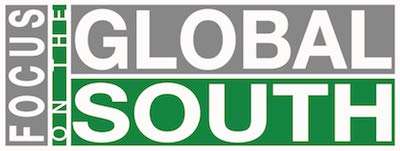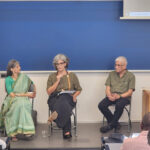By Nicola Bullard
According to the publicity, the Asia Pacific Economic Cooperation (APEC) is an economic forum composed of twenty-one counties bordering the Pacific, and accounts for 46 per cent of the world’s trade and over half of the world’s gross national product. Or, at least these figures were true six months ago before the financial crisis started to sweep through Southeast Asia wiping billions of dollars off national assets and earnings.
Although the idea of APEC was first raised by Japan in 1989, APEC made little progress until1993 when the US started to get nervous about progress on the Uruguay GATT and saw that an Asia Pacific free trade area could complement the already established North America Free Trade Area (NAFT), thereby bringing half the economic world into a fast-track trade and investment liberalisation regime. The US’ main interest in APEC was, and still is, to increase its markets by knocking down trade barriers and opening opportunities for foreign investment in the rapidly expanding economies of the Asian tigers.
But the free trade vision of APEC has never been fulfilled precisely because the Asian tigers believed that their own growth was dependant on protecting certain sectors of their economies — in particular agriculture – from lower priced and often subsidised products from Northern countries. While these economies were booming, it was politically possible for them to punch above their weight in the APEC negotiations, with the result that the few agreements that have been reached on trade liberalisation are voluntary and non-binding.
Power shift in APEC
But financial crisis has changed the Southeast Asian economies from pouncing tigers to purring pussy cats – with, of course, the notable exception of Malaysia’s Prime Minister Dr Mahatir Mohamed whose bravado and knack for provocation never disappoints.
And it is Dr Mahatir who articulates the deep divide within APEC. On the one side are the unreconstructed free traders — the US, Australia and Canada — who see APEC as the means to lever open Asian markets and liberalise investment by creating a regional free trade area. On the other is Malaysia, with behind-the-scenes support from Japan, favouring an Asia-only club, to promote technical cooperation and strengthen Asian political and economic influence.
Dr Mahatir resistance to the US’ aggressive free-trade agenda and coercive tactics are shared privately by many politicians and bureaucrats in the region. Yet his promotion of the East Asia Economic Grouping (EAEG) — comprising Singapore, Vietnam, Thailand, the Philippines, Indonesia, South Korea, Japan, China and Brunei — as a counterweight to the US and to promote Asia’s trade interests, has not gained ground thanks to unyielding US opposition which has effectively forestalled support in Asia.
Although Mahatir’s vision is still no more than that (except by default: the Asian side of the Asia Europe (ASEM) dialogue comprises exactly the EAEG countries) it is an idea which could still have its day.
Countries hit by the currency crisis, with mounting debts and plunging currencies, have few alternatives but to trade and borrow their way out of the red. The risk of trading out is that everyone is competing against each other, pushing prices lower and lower in a ‘beggar-thy-neighbour’ cycle. In fact, the strategic solution would be for the economies to unite forces, create a common market to develop and enhance inter-regional trade and to make sure that they are not played off against each other in the international market.
Of course being in a club with South Korea, Thailand and Indonesia is hardly an attractive proposition: not only are they mired in debt but are now firmly in the grip of IMF economic restructure policies backed by the US.
Ironically this is the very moment when Mahatir’s vision of a strong Asian counterweight to the US free trade agenda is most needed. Conspiracy theories (that have taken on the status of truth) that the Asian economies have been deliberately targeted because the West doesn’t like to see them getting ahead may seem incredible, but there is more than a grain of truth. As James Tobin, the Nobel Laureate economist who proposed a tax on all international currency transactions commented: “It is hard to escape the conclusion that the countries’ currency distress is serving as the opportunity for an unrelated agenda – including the obtaining of trade concessions for US corporations and expansion of investment possibilities.” (The Nation, 24 December 1997).
Japan to the rescue – almost
Early on in the financial crisis, Japan floated the idea of an Asian Monetary Fund — that is, a fund to supply a quick response line of credit – and proposed an initial capitalisation of $100 billion.
Japan had good reasons for putting its money on the table: First, Japanese banks are heavily exposed to Thailand, South Korea and Indonesia and it is in their interests to stabilise volatile currency markets.
Second, the Japanese economy is deeply embedded with its neighbours so any slow down or collapse would have a domestic impact.
Third, for some time Japan has promoted an Asia-appropriate development model in its dealings with international institutions such as the IMF and World Bank. Essentially, Japan has argued that the ‘Washington Consensus’ of rapid deregulation, reducing the role of the state and liberalisation of capital flows may not be the best path for countries which have followed a state-led development model, and that severing the links between the state and industry of the one hand, and the banks on the other would be politically unpalatable and may not achieve the expected results. In short, the Asian Monetary Fund was conceived as being more flexible, less doctrinaire and ‘more Asian’ than the IMF deal.
The Asia Regional Fund seemed like a good idea if for no other reason than to break the IMF monopoly on economic thought and open the market to new ideas and economic paradigms. The idea of financial institutions competing against each other for business certainly has its appeal!
But what seemed an essentially sound idea was quickly blocked by both the US and the IMF on the grounds that it would tempt Asian governments in crisis to take the ‘soft option’ when what’s really needed is the tough medicine of the IMF – to root out corruption, tighten bank regulations, get sloppy governments in shape, open investment and knock down trade barriers. Japan backed down, cowed one again by the US, and the Asian Regional Fund was finally buried at the Manila APEC Finance Minister’s meeting in November 1997 which gave the go-ahead to supplementary financing agreements, provided they are ‘in conjunction with the IMF and its strict lending standards.’
The IMF and US victory on this issue was a defeat for Japan and a set-back for any chance of a strong Asia-led, as opposed to IMF-led recovery.
IMF – the masked marauder
On the other hand, the IMF’s deep penetration into Asia, via the currency crisis, has strengthened the US position in the region. Since the debt crisis of the 1980s, the IMF has been an instrument of economic liberalisation and free trade, through stabilisation and structural adjustment programs, and has worked hand in glove with the US to promote and impose this agenda.
The rollback of trade and investment protectionism and activist state intervention has already been incorporated into the IMF stabilisation programs that have been negotiated or are being negotiated with Thailand, Indonesia, and South Korea. Thai authorities have agreed to remove all limitations on foreign ownership of Thai financial firms and are pushing ahead with even more liberal investment legislation that would allow foreigners to own land, a practice that has long been taboo in that country.
Even before it sought the help of the IMF, Jakarta abolished a 49 per cent limit for foreign investors to buy initial public offering (IPO) shares in publicly listed companies.
In the case of Korea, the final package negotiated with the IMF allows foreigners to buy 50 per cent shares in South Korean companies — a figure that will rise to a controlling 55 per cent in 1998 — and permits foreign banks to hook up with South Korean banks in merger-and-acquisition agreements. Foreign investors are also allowed to buy up to 30 per cent of long-term guaranteed corporate bonds, a right they have been seeking for years in order to exploit a $64 billion market.
In six months, the financial crisis in the region and the international response has done more to advance the free trade and investment liberalisation aspirations of the US that the past six years of APEC summits. This is unfortunate because the weakness of APEC was also its strength. That is, APEC’s unwieldy size and diverse interests and economies ensured that progress was slow, incremental, non-binding and voluntary. Effectively this put the brakes on rapid liberalisation and provided the space for some of its members to resist pressures to dive headlong into the shark infested waters of the open market.
Forget the noun, where are the alternatives?
With the IMF firmly installed in the region and trade and investment liberalisation on track, the US may quickly lose interest in APEC. Way back in 1994 former Australian Foreign Minister Gareth Evan’s 1994 quipped that APEC is ‘four adjectives in search of a noun’. Maybe we can stop searching for the noun and start looking for alternatives.
As a start, the idea of an East Asian Economic Group should be revived, with its main task to present a collective and united response to the economic crisis.
Some of the immediate tasks would be to:
First all the countries receiving IMF bailout packages must, together, re-negotiate the terms. The renegotiation must be on the basis that a large part of the foreign debt is private and that both private debtors and lenders must be forced to accept the penalties of the market for making the wrong decision. The burden of debt must not be pushed onto the people, which is the IMF solution. Public money must not be used to bailout the big private creditors and debtors.
Second, work to establish mechanisms to control international capital flows. One of the main factors contributing to the economic crisis was the uncontrolled flood of speculative finance pouring into non-productive and high risk sectors of the economies. Priority should be given to opposing the proposed Multilateral Agreement on Investment which is an undisguised attempt to further protect the interests of transnational corporations.
Third, establish a ‘common market’ and a programme for coordinated regional development, where members would favour one another’s goods and keep prices up against third parties. This would stop beleaguered economies from competing against each other and forcing prices lower, benefiting no-one but the buyer.
Fourth, establish an Asian Monetary Fund, mobilising the massive reserves of Japan and China, to protect currencies from speculative attacks and to bring them back to realistic exchange rates.
There are also issues of corruption and democratisation to be addressed domestically, and the economic crisis has certainly brought these into sharp relief, and may well precipitate dramatic social and political change in the region. But, these we have to take up ourselves: I know of no case where the IMF adjustment package has achieved its economic objectives, let alone the social and environmental objectives that we would share.
*Nicola Bullard is a senior associate with Focus on the Global South







